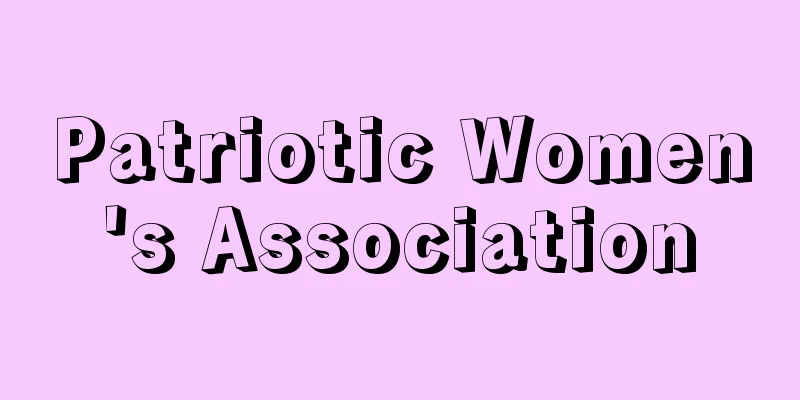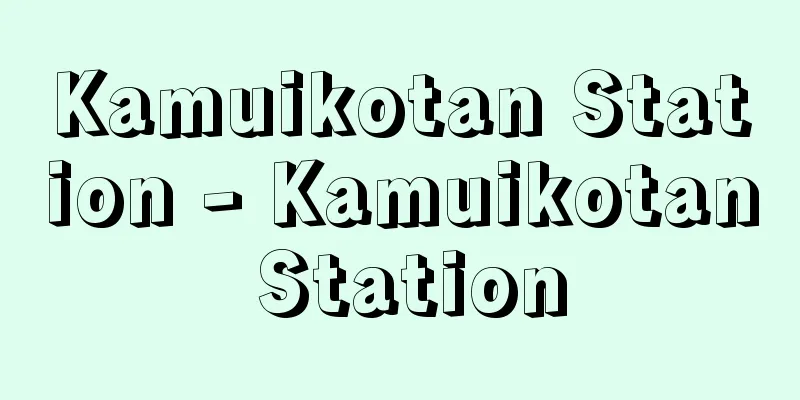Patriotic Women's Association

|
A women's group with the goal of supporting the military before the war. It was founded by Okumura Ioko on February 24, 1901 (Meiji 34) (the opening ceremony was held on March 2). The motivation for the organization was that Okumura had inspected the battlefields of the Boxer Rebellion (Northern China Rebellion) the previous year, and realized that soldiers should not be made to worry about their future. Initially, the main purpose of the organization was to provide relief to the families of those killed in battle and seriously injured soldiers, and women pooled together the cost of a half-collar to contribute to membership fees and donate the money as condolence money. The organization had wives of members of the imperial family and prominent aristocracy as presidents and chairpersons, with its headquarters in Tokyo and branches in various prefectures, and in 1902 it published its journal, "Patriotic Women." By 1905, during the Russo-Japanese War, the organization had more than 460,000 members. After World War I, the association also began social work such as child health consultations and job introductions for women. After the Manchurian Incident (1931), the association launched a women's patriotic movement in opposition to the Greater Japan Women's Association for National Defense, which was established by the military, and carried out volunteer work on Chikyusetsu (the Empress's birthday) and a patriotic savings campaign. On February 2, 1942 (Showa 17), the association was merged into the Greater Japan Women's Association (at the time of the merger, the membership was approximately 4 million). [Tsunehisa Abe] "The 40-Year History of the Patriotic Women's Association, by Hidekazu Tobishi (1941, Patriotic Women's Association)" [Reference item] |Source: Shogakukan Encyclopedia Nipponica About Encyclopedia Nipponica Information | Legend |
|
戦前の軍事後援を目的とする婦人団体。1901年(明治34)2月24日奥村五百子(いおこ)により設立された(発会式は3月2日)。動機は、奥村が前年義和団(ぎわだん)事件(北清(ほくしん)事変)の戦地を視察したとき、兵士に後顧の憂いをもたせてはいけないと感得したことにある。当初、戦死者の遺族と重傷痍(じゅうしょうい)軍人の救護を目的とし、婦人が半衿(はんえり)一掛を節約して会費を出し合い、それを弔慰金として寄贈することを主事業とした。皇族や名流華族夫人を総裁、会長にいただき、東京に本部を、道府県に支部を置き、1902年機関誌『愛国婦人』を発行、日露戦時の1905年には46万余の会員を数えた。第一次世界大戦後には、児童健康相談、婦人職業紹介などの社会事業にも着手。満州事変勃発(ぼっぱつ)(1931)後、軍部のつくった大日本国防婦人会に対抗して婦人報国運動をおこし、地久節(ちきゅうせつ)(皇后誕生日)奉仕や愛国貯金運動を行った。1942年(昭和17)2月2日大日本婦人会に統合された(統合時の会員は約400万人)。 [阿部恒久] 『飛鋪秀一著『愛国婦人会四十年史』(1941・愛国婦人会)』 [参照項目] |出典 小学館 日本大百科全書(ニッポニカ)日本大百科全書(ニッポニカ)について 情報 | 凡例 |
<<: Battle of Aegospotami - Battle of Aegospotami
Recommend
Sajama Mountain (English spelling)
An extinct volcano in the Western Andes of Bolivia...
Wilkins, C.
…In 1783, the British judge W. Jones (1746-94) wa...
Takamiya
The name of Inukami-gun, Omi Province. In the curr...
Hang glider - Hangglider (English spelling)
A general term for unpowered aircraft (gliders) t...
Tiger longhorn beetle - Tiger longhorn beetle
A general term for insects belonging to the Clyti...
Rational formula
…Ethyl alcohol and methyl ether have the same mol...
unendliche Melodie (English spelling) unendliche Melodie
...Methods of pure musical order include contrast...
Transitional cell carcinoma
...therefore, they are further classified accordi...
Sartaqtai
…A term used to refer to the inhabitants of oases...
Inclination
...In mathematics, gradient is defined and used a...
Eating together - Kyoshoku
Eating together is a way of expressing community ...
Blood Type AB - E-B-Gata
...It is said that one of the triggers for this d...
Peristylium
…The significance of the excavation of Pompeii li...
Capsule-shaped spaceship
...In the early days, universal spacecraft that c...
Talitridae
…When they come onto land, they move by jumping, ...









